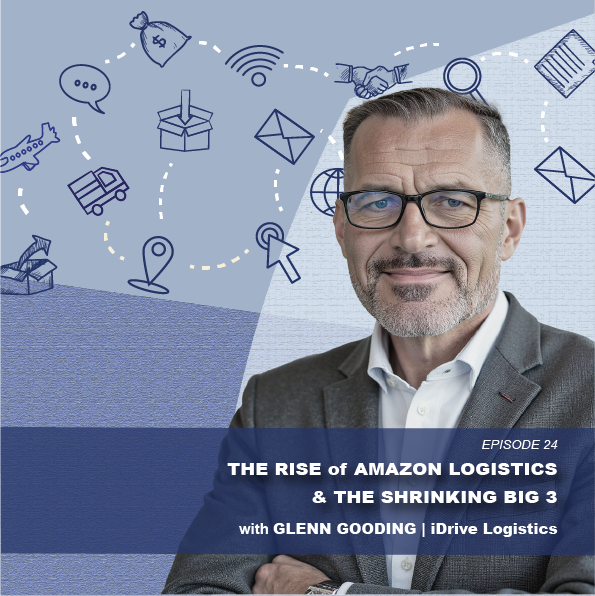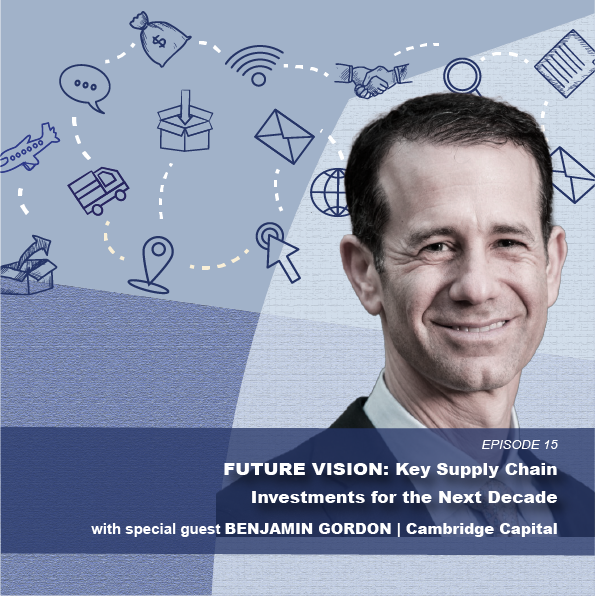
In this episode of Parcel Perspectives, Glenn Gooding breaks down how Amazon Logistics has quietly become the second-largest parcel carrier in the U.S.—and what that means for traditional players like UPS, FedEx, and USPS.
Drawing on ShipMatrix data and years of network experience, Glenn explains how market share is shifting away from legacy carriers toward retailer-led delivery and emerging gig providers. He outlines the implications for shippers as pricing power consolidates and access becomes more segmented, especially for SMBs.
The episode also highlights how 3PLs are helping level the playing field, offering aggregation, access, and flexibility in an increasingly fragmented network.
[00:00:00] We can see that annual parcel volume is projected to grow. However, the majority of that growth is going to be attributed to the growth of Amazon – Prime, that is – the growth of Walmart, the growth of Target. So, what that means is that UPS, FedEx USPS are going to be left fighting for a static market share.
[00:00:28] Welcome to Parcel Perspectives, the podcast dedicated to small parcel shippers. I’m Glenn Gooding. In each episode, we dive into insights, best practices, and strategies to help you navigate this complex and costly market.
[00:00:43] Welcome back to Parcel Perspectives. I’m your host, Glenn Gooding. In today’s episode, we’re going to take a dive into one of the most important, and I think, overlooked shifts happening in the shipping world – the rise of Amazon Logistics as a small parcel delivery company, and what it means for the legacy players like UPS, FedEx, and USPS.
[00:01:08] Not sure if you realize it, but Amazon now handles more than one out of every four parcels shipped in the US and it is not just Prime packages. Meanwhile, traditional carriers are losing volume, raising rates, and struggling to adapt to a lightweight residential delivery.
[00:01:30] Ultimately, what does this mean for your shipping strategy? Should you be rethinking your carrier mix? Let’s unpack what’s changing in the small parcel landscape and how to turn this fragmentation into an opportunity for your business. So, a lot to take away out of this. I hope to offer great value for you.
[00:01:52] I’m going to pop up a graphic. So, what I have up here I want to source properly first. My friends at ShipMatrix provided this data, so thank you, ShipMatrix. What we have here is US domestic parcel volume market share. It’s volume-based, and we can see some very interesting macro trends, as we trend from 2019 through the COVID era and into 2025.
[00:02:25] What I think particularly stands out with this is you can see that UPS, FedEx, and USPS are having a shrinking market share in this environment. You can see that Amazon delivery now represents 25% – or as I previously stated, one in four – of the average daily volume in the US market, and the Others category is growing rapidly as well.
[00:02:55] I’d like to talk a good bit about what is happening there. eCommerce is growing. The USPS has their ‘Delivering for America’ plan. They’ve done a lot of things that I’ve mentioned in previous podcasts around the postal aggregator market, trying to drive volume into the Ground Advantage market, and ultimately imposed some hyper-inflationary dynamics into the lightweight residential market. And it’s opened up some areas of opportunity.
[00:03:28] First off, Amazon delivery, which had built up a robust capacity and network to accommodate growth for the Prime channel, particularly during the COVID era, is now finding themselves on the outside of that, or at the end of that, now having available capacity and they’re looking to fill that capacity and continue to grow the delivery network.
[00:03:54] They’re actively looking for direct to commercial relationships. And they can offer an excellent solution in the marketplace. That solution is pretty darn robust. If you’re looking at a standard ground service, one to five days time in transit, what you’ll find with Amazon delivery is a up to a seven day per week pickup, seven day per week potential delivery, multiple pictures of the delivery, a great customer experience, and true door-to-door delivery into every address in the United States minus PO boxes. So, they’re doing a nice job in that space, and they do quite well in what I would call the lightweight environment.
[00:04:51] Now, Amazon is a for-profit delivery company, as is UPS, FedEx, so they’re very sensitive to their profile. If you have dreams and aspirations of giving Amazon delivery all of your less-than-a-pound volume, think again. They’d certainly be willing to entertain some of that, but it needs to be offset with higher yielding packages as well in that.
[00:05:18] The chink in the armor, in my opinion, for Amazon delivery as it stands today, is they have limited service areas that they offer pickups. Okay, important to note. And they offer one modality today – the equivalent of a ground service. There is no air, nothing like that right now in the Amazon delivery environment. They’re making great end roads, though, in the marketplace on that front.
[00:05:46] USPS continues to lose market share for a variety of reasons, and we’ve talked about that for a long while. But the other piece that’s really diluting this is the other bucket. I wanna talk about ‘Others’ for a moment. ‘Others’ can constitute things like regional carriers – OnTrac (LaserShip, now OnTrac), LSO, right? GLS – I love them all and I’m not attempting to pick favorites as I list these out. I just want to give kind of illustrative examples of names of them.
[00:06:21] You also have some interesting market disruptors out there for lightweight, gig economy type of solutions. The SpeedXs, the UniUni’s the Veho’s of the world that offer technology-based solutions for lightweight and heavier packages that they will transport and induct to gig economy delivery service providers.
If that fits your model, that can be a really compelling alternative to the traditional lightweight solution that you used to use for postal induction via DHL eCommerce, UPSMI, Pitney Bowes, an OSM. They can do a nice job. They are a gig economy, and it will be very interesting to see how they handle peak season volumes and capacity constraints and things like that, but they’re making good end roads on that front.
[00:07:18] The other couple are ones that compete directly with Amazon as a retailer, and that’s Walmart and Target. They’re not going away. They’re innovating, they’re leveraging their footprints, and they’re developing their own final mile delivery solutions. And so you see them carving away market share, bringing their volume that they traditionally used to source to a UPS, to a FedEx, to a USPS and now bringing it in-house.
[00:07:51] So, in essence, what we have here is we have a kind of a reshuffling of volume within there. Now, if we play that forward – again, thank you to ShipMatrix – we can see that annual parcel volume is projected to grow. However, the majority of that growth is going to be attributed to the growth of Amazon – Prime, that is – the growth of Walmart, the growth of Target. So, what that means is that UPS, FedEx USPS are going to be left fighting for a static market share.
[00:08:37] Now, UPS and FedEx happen to be victims of their own making. What I mean by that is their legacy pricing revenue management policies are, I think, beginning to hurt them a bit.
[00:08:54] UPS and FedEx for the longest time, liked high revenue-per-package volume – multiple piece-per-delivery, high revenue-per-stop type of volume. They put in revenue management practices on a year over year basis that discouraged lightweight business, encouraged heavier weight, and then, as their networks became, let’s say, encumbered with heavyweight volume – things like 55, 65, 75 pound boxes, longer boxes, larger boxes – they began to challenge their network with non-conveyables, or what we call irregulars – it depends on the carrier you’re referring to; they have different nomenclature for those, but packets that are nonconveyable.
So, they created that. So, they started to attack the non-conveyable market by pricing it out of their network or making it pay for its way. And so now, they’re fighting over this illustrious, mysterious 10 to 20 pound box ideally going with another package.
00:10:05] Don’t forget: the small parcel market has always had a significant B2B component to it. However, it’s not experiencing growth like the eCommerce side.
[00:10:18] So, if you’re a B2B shipper, you’re becoming more of a coveted unicorn in the space. You have unique attributes, unique profitability profile for a UPS or FedEx that would make them want to work hard to retain your business and build that out.
[00:10:39] But the other thing that’s made this hard in the marketplace is UPS and FedEx are famous for trying to tie up the entire spend portfolio for a particular shipper. Those types of activities have been designed to force a shipper or [make them] feel a shipper has to manage against the performance language in a service agreement versus managing their business. And invariably, what will happen is it can force a shipper into giving parcels that it would rather give to another carrier in this dynamic market that might service that better in light of maintaining their savings level for all the other packages that are out there.
[00:11:27] Some illustrative examples of how UPS and FedEx are responding to this challenge: well, for those of you who haven’t seen my segment on fuel surcharge, I encourage you to watch it. Over the last three and a half years, UPS and FedEx have manipulated their fuel surcharge tables 14 times – 14 times, well over 1000 basis points. So, if you were to play that back, you would see that fuel if traded at a static cost over that time period has more than doubled in today’s market.
[00:12:10] That’s an illustrative example of what UPS and FedEx have done historically. Now they’ve done a number of other things with GRIs, different billing methodologies on additional handling, oversize, large package surcharges, adding fuel to other segments such as weekly service fees and address corrections and non-transportation-related type of charges, 2% ACH payment fees.
[00:12:37] Bottom line is folks UPS and FedEx are fighting over a smaller market share, and the way they’re attempting to make up their revenue shortfall is by billing you more and making it more complex.
[00:12:51] And that has to be frustrating, and it breaks my heart for them. So, what to do in this environment?
[00:13:02] I’ve talked a little bit about Amazon and about other disruptive carriers that align there. It’s important that in today’s world, you realize that not all packages are desirable to all carriers. Carriers have a profile or a sweet spot that they like. I think it’s important for you to begin to drill into your package profile and begin to identify on a whiteboard what segments of your profile make sense with which carrier is in the marketplace.
[00:13:38] Then, I think it’s important for you to potentially deconstruct your existing legacy agreements with the carriers that you currently source with, and determine how do you realign this and not subject your portfolio to an increase by potentially bringing an UniUni into the mix for a lightweight delivery solution.
[00:13:59] Now, it becomes even a little trickier. If you’re an SMB, you may not have the volumes to justify an Amazon delivery pickup. You may not have the volumes to justify an UniUni or a SpeedX or a Veho pickup. Those are challenges, so you’re kind of stuck, okay? USPS, UPS, FedEx, unless. you’re able to go out and potentially utilize a good sophisticated 3PL.
[00:14:37] One of the values, and I hope the carriers are listening to me here, one of the values that a 3PL can bring to the carrier is that they can aggregate volume and they can effectively make the volume profile more profitable to that given carrier from a cost perspective: greater pickup density, higher volumes. A good 3PL will have a robust portfolio. And if you’re an SMB, you may not have the volume to justify an UniUni solution, but when it’s combined with the remainder of the 3PL’s portfolio, you can now access carriers that you couldn’t previously.
[00:15:23] So, what this is doing is this is leading the market to, I think, a more profound 3PL-driven marketplace.
[00:15:36] A lot of details, a lot of challenges to accomplish this. It’s not as simple as going to a UPS or FedEx and say, “I’d like to carve away 30% of my profile. I’d like for you to give me better discounts on the remaining 70% I’m keeping with you, and I want you to allow me to give this to where it belongs in the marketplace.”
[00:15:58] Easier said than done. They’re not going to surrender that ground easily, nor should they. So, it takes a tremendous amount of industry knowledge, a tremendous amount of analytical capabilities, an extreme amount of knowledge around how a carrier pricing agreement works and how a carrier views your portfolio, and then, an ability to develop a compelling, incredible business case to go to the marketplace and help construct something that aligns your business for success in 2025 and beyond.
[00:16:34] A 3PL may be part of the answer for this equation. Key takeaways in this: the market is changing. It’s changing drastically. If you take out the big three retailers in the US, Amazon, Walmart, Target, we’re faced with a roughly stagnant or flat perspective on parcel growth in the US. Legacy pricing practices are opening the door for other competitors to enter the space. The gig economy providers, the regional carriers, Amazon Logistics, is making great headway on that arena. And as a result, we have a much more fragmented, much more competitive marketplace, and frankly, much more complex marketplace.
[00:17:31] Lean into your analytics. Find an expert. Lean into a good reputable 3PL.
[00:17:39] Hope you found this helpful. Hope it was beneficial. And by all means, if I can ever provide assistance, don’t hesitate to reach out.
[00:17:49] This is Glenn Gooding at Parcel Perspectives, and I look forward to my next podcast for you. Thank you.
[00:18:01] Thanks for listening to Parcel Perspectives, hosted by me, Glenn Gooding. I’ve been in the small parcel space for 37 years, starting with a deep and broad background, working for one of the major carriers as an operator and industrial engineer, later managing pricing at the highest level for the largest, most complex shippers in the world.
[00:18:19] Since then, I’ve been a national thought leader and worked to help drive strategy for clients from Fortune 50 companies to startup eCommerce businesses, helping them more competitively align in this complex and expensive market.
[00:18:32] If you enjoyed the show, please subscribe and share with friends. Join us next time for more expert advice and strategies to stay ahead of the shipping game.
Key Topics with Timestamps
- 0:43 The rise of Amazon Logistics and the new carrier landscape
- 3:28 Amazon’s delivery strengths—and its limits
- 5:46 The rise of “Others” and regional carrier dynamics
- 8:37 How legacy carriers are reacting to volume loss
- 12:51 What shippers can do in a fragmented market
- 13:59 The challenge for SMBs and 3PLs as the great equalizer
- 15:36 Strategic response
Other Podcasts
-
A Consultant’s Role in Supply Chain & Carrier Contracts
Discover how logistics consultancy revolutionized small parcel shipping for Right Manufacturing Systems in this episode of Parcel Perspectives. Join Glenn Gooding and Ian Hartman as they discuss achieving a 23% reduction in shipping costs, leveraging data for smarter decisions, and the invaluable insights gained from expert consultancy. Tune in to learn how deep industry knowledge and strategic negotiations can transform your logistics operations.
-
How Reverse Logistics Shapes Holiday eCommerce
Join Glenn Gooding and Cathy Roberson as they dive into the world of reverse logistics. Discover how carriers like UPS, FedEx, and USPS are adapting to the growing returns trend, and explore innovative strategies for handling oversized items and complex returns. Learn about the latest trends, including "bracketing" and sustainable practices, and how AI is transforming the returns process.
-
Future Vision: Key Supply Chain Investments for the Next Decade
The Future of Logistics is Here. Join Glenn Gooding and special guest Benjamin Gordon, Managing Partner and CEO at Cambridge Capital, in this week's episode of Parcel Perspectives as they explore the cutting edge of supply chain management. This episode covers it all: the AI revolution, the eCommerce explosion, the crucial role of customer experience, and the growing importance of sustainability. Get expert insights into future investment opportunities and discover how to build a resilient supply chain that can withstand any disruption. Tune in and future-proof your business!



